A Name Change
Prior to the start of the 1987-88 season the Club underwent a further name change.
This was brought about as a result of an amalgamation between Northern Districts and Bolwarra (formerly Black Hill) Cricket Clubs.
The name adopted by the new Club was “Northern Suburbs Cricket Club”.
Background of Bolwarra Club
From 1919 up until 1954 Black Hill Cricket Club had entered C grade teams at various stages in the competitions of the Hunter River District Cricket Association. Its sole competition success during those years was a C grade premiership in 1932-33.
At the start of the 1954-55 season the Club divided into two ‘separate Clubs – Black Hill No.1 with a home ground at Morpeth and Black Hill No.2 with a home ground at Black Hill near Minmi. The latter’s ground had a malthoid wicket and was located on Ron Fletcher’s property near the Methodist Church.
The first meeting of Black Hill No.2 Club was held at Les Fletcher’s residence at Tarro on September 8, 1954. There it was decided to enter a team in the C grade Club section of the Hunter River District Cricket Association.
To raise funds for the newly formed Club a raffle was conducted with first prize a sucking pig donated by Ron Fletcher. The raffle was drawn at a house dance held at Mrs.Snape’s residence at Black Hill and was won by Nurse Dooley from Maitland Hospital – not surprisingly Nurse Dooley opted to take the cash value of the sucking pig!
After winning the C grade premiership in its initial season, the Club progressed to B grade in 1955-56 and was again successful in winning the premiership. During that season the Club was strengthened by a number of Maitland Boys High School teachers, including Peter Searle, Errol Ingram, and Allan Forster, who traveled from East Maitland to Black Hill to play with the Club.
To celebrate the Club’s B grade success royal blue blazers with gold braid and lettering were purchased and these were presented by the Association President, Col Johnston, at a “The Cricketers’ V for Victory Ball” held at the Tarro Hall in July 1956.
The 1957-58 season again saw further growth in the Club with teams entered in second and third grade. The third grade team won the premiership this season and went on to defeat Volunteers in the final.
The Club took a major, step forward at the beginning of the 1958-59 season by entering teams in first, second and third grades. The Club also successfully negotiated for a wicket at Maitland Park and was granted use of the old Marist Brothers’ wicket behind Maitland Park Bowling Club.
At this stage the Black Hill No.1 Club became Morpeth United, so the No.2 Club was able to adopt the name “Black Hill” without the number attached.
During the 1960’s the Club struggled to establish itself and had only limited success, winning a third grade final in 1960-61 and a third grade division 2 premiership in1969-70. The tradition of a number of schoolteachers playing for the Club continued with Clem Ellis, Ian Wilson, Harley Longbottom, Kevin Ford, Keith McLeod, Allan Wickham, John Archer, Ken Redman, and Lindsay Wood joining the ranks.
Having survived some difficult years and having been on the receiving end of some “drubbings”, the Club was much more successful in the 1970’s.
In 1972-73 the second grade division 2 team won the premiership and the following season the Club’s first grade team contested its first final, losing to Northern Districts by one run. In 1974-75 the third grade won the minor and major premierships.
The Club’s best season was in 1975-76 when it won the Club Championship and had all three teams in the finals, winning the major premierships in first and second grades and narrowly losing to Northern Districts in third grade. In 1976-77 the Club repeated its Club Championship success and the second grade won the minor and major premierships. The following season the second grade continued its success by winning the major premiership.
With the advent of district cricket imminent, the Club changed its name in 1979-80 to Bolwarra Cricket Club and two seasons later was included as one of the eight district clubs in the new competition format. A few seasons later in an attempt to increase its district identification, the Club began using Bolwarra Oval as its second home ground.
However, the “glory days” of the Club were just about over. The only competition successes achieved by the Club under the Bolwarra name were a joint win of the Hunter Vattey Prudential Cup competition in 1979-80, the Club Championship in 1980-81, a second grade major premiership in 1981-82, and a B grade Div.2 minor premiership in 1986-87.
For their long association and service with Black Hill and/or Bolwarra Club, Life Membership was awarded to George Sutherland, Don Latter, Clem Ellis, Lindsay Wood, Darrell Andrews, Graham March, Glen Watts, Trevor Holden, Greg Watts, and Robert Campbell.
During its existence, the Black Hill/Bolwarra Club produced a number of talented cricketers. One of the best to play with the Club was Doug Weakley. A former State Under 14 Schoolboy representative, Doug played with Black Hill in the 1960’s. A dashing batsman with an attractive repertoire of shots, he was a delight to watch when in “full flight”.He captained the Maitland John Bull Shield team and the Hunter Valley Colts was selected for Combined Country Seconds, and represented Northern NSW in a match against India at the Newcastle Sportsground. Unfortunately, Doug was lost from the Club and Maitland cricket when he transferred to Brisbane in the second half of the 1967-68 season.
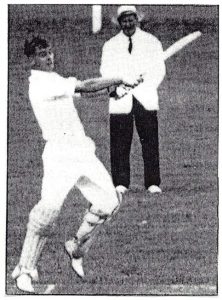
The Club was also particularly strong in its junior players, especially during the 1970’s. Many of these were drawn to the Club through the “teacher-school network” and through playing in the Club’s junior teams in the Saturday morning competitions. Among the talented juniors from the Club who went on to make their mark in first grade were Darrell Andrews, Tony Foot, Doug Elphick, James Elphick, David Parrey, Greg Watts, James Ryan, Alan Welts, and Craig McEntyre.Two of these – Doug Elphick and Craig McEntyre – later played in the Sydney first grade competition and Tony Foot toured NZ with the Emu Colts.
Early Links
It is interesting to note some of the early links between Black Hill/Bolwarra and Northern Districts Clubs prior to their amalgamation.
On entry into first grade, Black Hill’s first match was a two-day fixture against Northern Districts on 4th and 11th October 1958. At the end of the first day’s play, Black Hill appeared to be in a winning position as they were 5-94 in reply to Northern Districts 138. However, Northern Districts came back strongly on the second day to dismiss Black Hill for 118 and then went on to gain an outright win by scoring 3-107 and routing Black Hill for 50. In that first season, Black Hill was to finish on the bottom of the first grade points table with 21 points while Northern Districts finished at the top with 95 points.
Two seasons later in another match against Northern Districts at Lorn on 21st January 1961, Black Hill recorded the lowest post-war innings score in a first grade match in the history of the Association. The team was dismissed for the grand total of 11 runs!
The destroyers for Northern Districts were John Brown and Keith Smith, who ripped through the Black Hill batting line-up. lt may have been some consolation for the Black Hill players to know that back in 1928 Morpeth first grade had recorded an even lower total of 7 runs against Robins!
Prior to the amalgamation, quite a number of former Northern Districts players transferred over to Black Hilt/Bolwarra. Among these were Keith McLeod, Trevor Holden, Paul Moore, Aub and Romney Newman, Terry Finch, Graham Thomas, John Archer, Michael and Laurie Quinn, Jason Seymour, Les Vickery, John Tobin, Jeff Crittenden, and Tony Eckford.
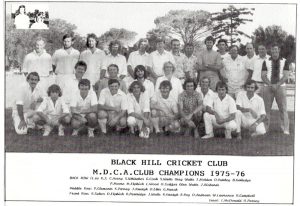
On the reverse side, some players such as Paul Mayers, Brad Nicholson, Robert Tynan, and Paul Clements played in Black Hill junior teams and then went on to play in the senior competition with Northern Districts.
Amalgamation
The amalgamation of Bolwarra and Northern Districts to form Northern Suburbs Cricket Club took place at a meeting on 22nd May 1987 at Lorn Park Bowling Club.
Prior to the meeting negotiations had taken place between representatives of both Clubs at the end of the 1986-87 season to pave the way for the proposed merger.
With the decline in their playing strength, both Clubs had become concerned about their future and many felt that an amalgamation of the two Clubs which were closely related in their district identification would be of mutual benefit. However, at first, there were some reservations relating to previous loyalties, the name change, and financial matters that had to be overcome.
As it turned out, the amalgamation certainly boosted the playing strength and numbers of the new Club. However, on the “downside” it did create the initial problem for the first two seasons of having to cope with administering seven senior teams – a very difficult proposition particularly considering the financial costs involved and the problems associated with selections and finding late replacements.
One “carry-over effect” of the amalgamation was that the new Club had three turf wickets as its home grounds – Lorn Park, Bolwarra Oval, and Black Hill wicket (at Maitland Park). While this brought the benefit of more players having the opportunity to play on turf instead of concrete, it also brought with it the problem of finding three curators and providing each with equipment in working order.
Despite the “teething problems” the amalgamation proved successful in the long run and generated a spirit of optimism in the new Club. It also provided the Association with the opportunity to promote Thornton from Club to District cricket without creating a bye or relegating another Club.
The Club’s first executive reflected the merger with the President, Trevor Holden, and the Treasurer, Rick Lantry, both coming from the former Bolwarra Club while the Secretary, Todd Bowd, came from Northern Districts.
Trevor Holden, the foundation President of the new Club, had played his early cricket with Northern Districts before transferring to Black Hill in 1968-69. There he soon established himself as one of the Club’s and District’s leading cricketers. He captained the first grade team from 1971-78, leading it to a first grade major premiership in 1975-76 for the first time in the Club’s history.
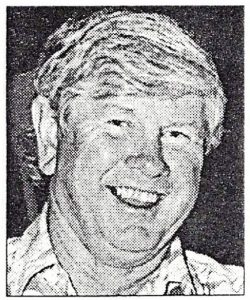
He also represented Maitland in the John Bull Shield and Hunter Valley in ‘Country Zone Trials. He was President of the Club from 1975-81 and was mainly responsible for initiating the name change for the Club from Black Hill to Bolwarra.
He was also involved in the administration of the Association, serving at various stages as Assistant Secretary, Secretary, Vice-President, and later on as President.
Todd Bowd, the foundation Secretary, had served as Secretary of Northern Districts for the two seasons prior to amalgamation. He was described by the Club President, Mick Hopkins, as “a tireless worker for the Club” and as “a real Secretary with a fox-terrier approach”. He started playing first grade with the Club in 1982-83 at the age of 15 and soon developed into an opening batsman with a lot of potential. In 1983-84 he scored 344 runs and the following season posted his first century in a high-scoring match against City United. ln 1986-87 he was one of the District’s leading batsmen with 430 runs and also scored 210 runs as a member of Maitland’s winning John Bull Shield team.
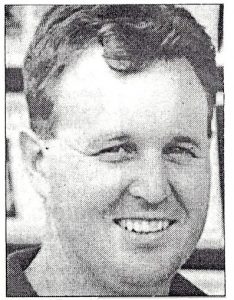
In his first season with Northern Suburbs, he topped the District batting aggregate with 630 runs, including 123 against Thornton at Lorn Park, and was again in a winning John Bull Shield team.
He then left the club to play a few seasons with Newcastle University. After a short retirement, he returned to play with Northern Suburbs in 1996-97. After scoring a century in second grade, he was promoted to firsts, but unfortunately broke his arm and was out of action for the rest of the season.
Some Vintage Seasons
Success did not immediately follow the amalgamation. In fact in the first season after amalgamation in 1987-88; out of seven teams entered by Northern Suburbs only on eteam; third grade; made the semi-finals. The three teams entered in the club section fared particularly badly, finishing either last or second last.
However, the picture soon brightened and the new club was to enjoy what might be described as “vintage seasons” during the period up to 1997.
One of these was 1988-89 when the club won the Club Championship, together with the Minor Premierships in first, second, and third grades. The club also won the Jim Watson Memorial Shield for the district club amassing the most Player of the Year points.
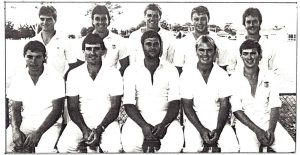
Front (Left to Right): G. Cooke, P. Johns, N. Lutovac (Captain), D. Parrey, S. Goodman.
Another top season was in 1990-91 when the club took advantage of the Association’s introduction of a fourth and fifth grade to enter five teams in the District Competition. The Club again won the Club Championship, the minor and major premierships in second and third grades, and the minor premiership in fifth grade.ln addition the fourth grade were Finalists and the Club reached the final of the Prudential Cup competition.
1996-97 was also a memorable season with the Club almost “scooping the pool” in District cricket. The Club won the Club Championship and minor premierships in first, second, and fifth grades. All five teams played in the finals with the first, second, and fourth grades emerging as major premiers.
Other Successes
Apart from the above vintage seasons the Club also had more than a sprinkling of successes during the decade up to 1997.
The Club won two more Club Championships in 1992-93 and 1995-96 – making it five out of ten Club Championships in the first ten seasons after amalgamation.
Among other successes were a C grade Division 3 major premiership in 1989-90; a second grade minor premiership in 1991-92; a first grade minor premiership and fourth grade minor and major premierships in 1992-93; a third grade minor and major premiership in 1993-94; a third grade minor premiership and a fifth grade major premiership in 1994-95; and a first and fourth grade minor premiership in 1995-96.
A major disappointment during this period was the performance of the first grade in 1993-94. The team went through the entire season without recording a single win
to finish at the bottom of the points table.
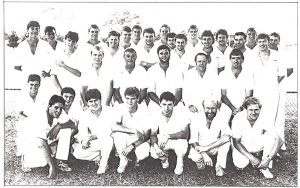
Another relatively low spot was in 1995-96 when all five teams made the finals only to be defeated in all matches.
Three First Grade Finals
In the ten seasons after amalgamation Northern Suburbs’ first grade team played in three first grade finals, losing two and winning one.
1988-89 Final – After finishing as minor premiers and defeating Western Suburbs in the semi-final, the Club’s first grade team under the captaincy of Nick Lutovac came up against Eastern Suburbs in the final.
Eastern Suburbs were dismissed for the moderate total of 177 with the best of the bowlers being Glenn Murphy with 3 for 60 off 28 overs. In reply, Norths were in trouble at 6 for 87 but were held together by a superb innings by Geoff Cooke. The turning point came when Geoff was dismissed for 62 with the score at 9 for 165. They were finally dismissed 13 runs short – “so close and yet so far away”.
1995-96 Final – Under the captaincy of Matthew Wilks, Northern had finished the competition rounds as minor premiers, losing only one match to Western Suburbs. After defeating Eastern Suburbs in the semi-final, Northern was opposed to Western Suburbs in the final.
Following an opening partnership of 145 between Matthew Brennan (115) and Terry Crittenden (85), Western Suburbs were dismissed for 321. As the West batsmen chased quick runs at the end of the innings, Northern made a strong fightback to take six wickets for just seven runs.
In reply Northern at one stage were 5 for 226 with Jamie Elphick scoring 51, Mark Meskauskas 60, and Brett Ward 38, with Tony Fort still at the crease, Northern supporters still held out hope. However, the side was all out for 281, with Tony 65 not out.
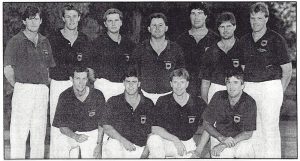
Front (Left to Right): D. Wilkinson, M. Wilks (Captain), T. Fort, P. Johns
1996-97 Final – Following a washout in the semi-final against Raymond Terrace, Northern Suburbs as minor premiers, with Paul Dyson as captain, progressed to the Final against Thornton.
On the first day, Thornton compiled a formidable total of 8 for 281 off their 80 overs.
Northern made a positive start to the run chase with Mark Meskauskas (37) and Dominic Wilkinson (39) putting on 79 in quick time. Batting at No.3, Tony Fort played one of the best pressure innings seen in Maitland cricket for some time, scoring 94 not out to steer the team to victory with three overs to spare. He was given strong support in the closing stages by Brett Ward (37), Jamie Elphick (37), and Matthew Wilks (20 n.o.).
Following on the preceding two losses in finals in 1988-89 and 1995-96 and the humiliation of the “win-less” 1993-94 season, the victory was particularly satisfying and long-awaited.
First Grade Blend
As a result of the amalgamation, the first grade during this period had a blend of former Bolwarra and Northern Districts players.
Among the former Bolwarra players who made their way into first grade were Terry Punch, John Enright, David Parrey, Peter Keith, Mark Daniels, Craig Jurd, Mark Meskauskas and Jamie Elphick.
The first grade was further strengthened by a number of “imports” from other Clubs, including Craig Garbutt, David and Brett Ward, Phil Carter, Anthony Gibb, Geoff Cooke, Rod Faulkner, Brad Schmidt, Mark Peno, Tony Fort, and Paul Dyson.
The period also saw the return to first grade for a few seasons by former Northern Districts’ players, Nick Lutovac, Glenn Murphy, and Phil Warby.
The main front-line opening bowlers were Rod Faulkner, Matthew Wilks, Stainton Priestley, Glenn Murphy, Geoff Cooke, and Ian Wood.
In the spin department, the attack was carried by Paul Johns, David Parrey, Phil Warby, Tony Fort, and Paul Dyson.
With batsmen of the calibre of Todd Bowd, Phil Carter, David and Brett Ward, Jamie Elphick, Dominic Wilkinson, Mark Meskauskas, Tony Fort, Nick Lutovac, and Paul Johns, the first grade was particularly strong in batting.
Wicket-keepers included John Enright, David Leary, Duncan Elphick, and Shaun O’Connor.
There was quite a “turn-over” of captains with no fewer than eight assuming the role at various stages – Paul Johns, Nick Lutovac, David Parrey, David Ward, Brett Ward, Tony Fort, Matthew Wilks, and Paul Dyson.
Paul Johns
Paul Johns started playing first grade with Northern Districts in the second half of the 1983-84 season.
Prior to that, he began his first grade career with Weston-Kurri, playing with the Coalfields Club from 1967-72. ln 1972-73 he transferred to Waratah in the Newcastle district competition, before returning to play two seasons in the Maitland competition with Western Suburbs.
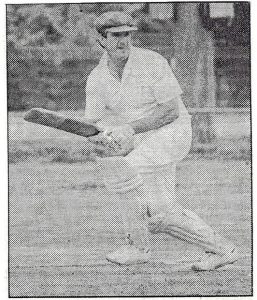
After being transferred to a teaching appointment, he played first grade for Gilgandra for five years.
He then played for the Wentworthville Waratahs in the Parramatta first grade competition, winning two premierships before joining Northern Districts in 1983-84.
In that first “half-season” with the Club, he showed what a real acquisition he was by scoring 287 runs and taking 30 wickets at the top District average of 9.8. He also produced a number of all-round match-winning efforts which helped take the team to a co-minor premiership and the major premiership.
Apart from a couple of short breaks and a second grade stint in 1993-94, Paul continued to play first grade with the Club up until the end of 1996, captaining the team for two seasons from 1986-88. During those thirteen years, he had some very successful seasons with bat and ball and showed his versatility in later years by reverting from fast to off-spin bowling.
For five consecutive seasons from 1983-88, he headed the Club’s bowling aggregate. In 1987-88 he topped the District’s bowling aggregate with 36 wickets and scored an unbeaten century (130 n.o.) in a match against East Maitland at Lorn Park. His best season with the bat was in 1989-90 when he topped the District aggregate with 521 runs. In 1988-89 with 266 runs and 32 wickets he was runner up in the Association’s Player of the Year Award.
Paul was very active in the administration of the Club. He was Secretary from 1988-90 and also served as Social Committee Chairman, Selector, Vice-President, and Publicity Officer. He was curator for a couple of seasons and as a member of the Club and Oval Board played a major role in helping to bring about improvements to the pavilion, ground, and wicket at Lorn Park. In recognition of his services to the Club Paul was made a Life Member.
At one stage when Paul indicated that he was about to take a break from cricket, the Club President, Bruce Leary paid the following tribute to him: “Paul Johns has announced that he will be having time out in the 1990-91 season – this will create a large hole in the club. On the cricket field, Paul has been the backbone of the first grade for too many seasons to remember, and off the cricket field Paul has been the driving force behind organising so many of the club’s activities that other clubs now envy.”
Halfway through the 1996-97 season, Paul left the Club after a “falling-out”- a disappointing ending to an association with the Club by someone who had made such a major contribution both on and off the field.
David Parrey
David Parrey made his first grade debut in 1975-76 at the age of 15 with Black Hill Club, after having played in that Club’s junior teams and lower grades. In that first season in first grade, he took 25 wickets and scored 169 runs.
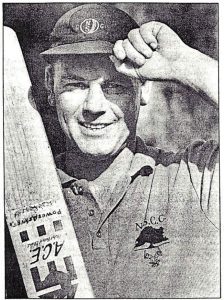
As an off-spin bowler, attacking middle-order batsman, and an excellent slips fieldsman, he continued to play first grade with Black Hill (later Bolwarra) up until 1980. During that time he also represented Maitland and the Hunter Valley at Colts level.
Following the amalgamation, he came back to play with Northern Suburbs. After starting off the 1987-88 season in A grade and scoring 296 runs, he was promoted to first grade.
He remained a regular first grader up until 1992, and captained the team in 1990-9. 0ne of his best seasons was in 1989-90 when he scored 411 runs, with a highest score of 94.
It was not until he played second grade in 1993-94 that he scored his first century – 126 in a match against West on Workers.
After retiring for a couple of years, he later made another comeback to first grade playing for Tenambit Morpeth.
Geoff Cooke
Geoff Cooke only had one season – 1988-89, with Northern Suburbs but it was a memorable one.
He came across from Hinton Club after having played in the Club competition and had a meteoric rise up the cricket ladder. It took him just two games to be promoted to first grade.
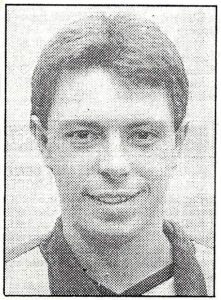
After scoring 86 not out in an A grade match, he went to seconds where he scored a spectacular 207, including 24 fours and 11 sixes in a match against Tenambit-Morpeth at Morpeth.
He put on 91 runs with Andrew Whitney for the ninth wicket and 88 with Terry Punch for the tenth wicket, during which time Terry did not score a run. He took the score from 8-90 to 10-269 to set up a match-winning total.
In first grade, he scored 307 runs and took 19 wickets for the season. In the final against Eastern Suburbs, he played a superb innings of 62 which almost brought victory to Norths.
In that first season in District cricket, he also had outstanding success at the representative level. Playing John Bull Shield for Maitland, he took 13 wickets and was named Representative Player of the Year. He also represented Hunter Valley in the Colts and Under 24 teams. He was selected in the Emu Colts team and following a very successful Under 24 Carnival at Maitland where he scored two fifties and took seven wickets, he was chosen in the North West Under 24 Zone team that competed in the Combined Carnival at Singleton.
Northern Suburbs was to have the services of this talented all-rounder for just the one season. After 1988-89 he moved on to play in the first grade competitions in Newcastle, Sydney, and Cessnock before returning to coach and play with Tenambit-Morpeth in the Maitland competition in 1996-97.ln the course of those years he also gained higher representative honours by being selected to play for NSW and Australian Country on a number of occasions.
David Ward
David Ward transferred from Tenambit Morpeth Club to Northern Suburbs in 1991-92.
During the 1980’s he had been one of the District’s leading batsmen, scoring 433 runs in 1984-85 and 497 runs, including three centuries, in 1988-89. He had also represented Maitland in the Colts and John Bull Shield competitions.
In the season prior to his change of clubs, he had scored over 500 runs – the benchmark of a top-class batsman.
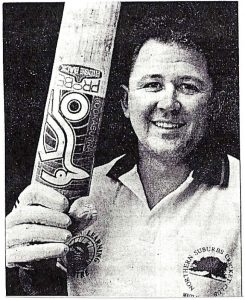
His start to the 1991-92 season with Northern Suburbs was delayed by a protracted dispute with his former Club over a clearance.
He also found himself elected to the position of first grade captain after David Parrey stood down shortly after the start of the season. Those distractions possibly affected his own form as he only scored 105 runs and took 9 wickets.
However, there was nothing disappointing about his leadership skills. As the President, Bruce Leary, noted in the Annual Report: “If ever a young player is looking for a role model in attitude and loyalty to his club, look no further than David. He gave everything for the success of the Club and I personally think he was club man of the year. David Ward replaced ‘Sparra’ as captain and immediately gained respect from all in the club … and I predict big things under his leadership.”
The President’s prediction was not far out for in the following season David again led the first grade team – this time to a win in the minor premiership. As the opening batsman, David was back to his old form scoring 434 runs, including two consecutive centuries (126 against Thornton and 109 not out against Eastern Suburbs). With his medium-pace bowling he also “chipped in” to take 12 wickets.
He continued to play first grade for another three seasons before stepping down to captain the second grade team. There he had an outstanding first season, leading the team to a win in the minor and major premiership. He was also named by the Association as the second grade Player of the Year and headed that grade’s batting aggregate and average with 511 runs at an average of 50.
Among his performances in second grade was a remarkable 225, including 12 sixes, scored in a match at Morpeth against his old Club, Tenambit-Morpeth. At the start of the final over of the day, he was on 199, but instead of prodding for a single to reach a double century, he hit 26 runs off the over, bringing up the side’s 400 at the same time.
He had further success in the 1997-98 season leading the second grade to back-to-back minor and major premiership victories. He also finished second in the District aggregate with 480 runs.
He continued to play second grade up until 2003 and still had considerable success, topping the District aggregate in 2000-01 with 436 runs and leading his team to major premiership wins in 2001-02 and 2002-03.
Brett Ward
Brett Ward, David’s younger brother, played first grade with Tenambit-Morpeth and Eastern Suburbs before transferring to Northern Suburbs in 1992-93.
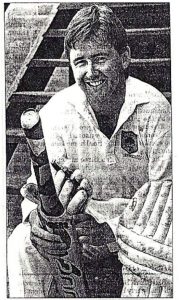
A left-hander, Brett had been one of the District’s top run-getters scoring 459 runs with Eastern Suburbs in 1990-91 and 350 in 1991-92. He had also been very successful representing Maitland Colts for a number of seasons in the eighties.
On his transfer to Norths, he made a spectacular start by scoring 97 and 87 in his first two matches.
He finished the season with an aggregate of 417 runs at an average of 46.3.
In 1993-94 he took over the captaincy from his brother, David. Team-wise the season was a disappointing one as first grade failed to win a single match. However, Brett’s own form with the bat was still very solid and he scored 358, including a century, at an average of 44.7 to top the Club’s batting aggregate and average.
The following season he scored 245 runs and in 1996-97 was a member of Norths’ successful first grade team that won the minor and major premierships. Brett contributed to that success by scoring 242 runs, including 126 against Easts and a valuable knock of 37 in the final against Thornton.
A move to Sydney shortly afterward meant that the services of this talented and popular player were lost from the Club.
Some Notable Achievements
Some notable individual achievements worthy of acclaim during this period were:
– Steve Lantry taking all ten wickets in a third grade match against Thornton at Bolwarra Oval in the 1988-89 season;
– Glen Barnes scoring 195 in a third grade match against Eastern Suburbs at Fieldsend Oval in the 1992-93 season – his innings included 27 fours and 5 sixes;
– Reg Rogers’ all-round performance in third grade in 1993-94 when he scored 328 runs, including a century against Weston Workers, and took 13 wickets, including a hat-trick against Eastern Suburbs – also scored 43 runs and took 7-58 off 32.4 overs in the final against Tenambit-Morpeth and was named the Association’s Third Grade Player of the Year;
– John Enright’s five wicketkeeping catches in a first grade match against Thornton at Lorn Park in the 1992-93 season to equal the District record at that time;
– David Leary’s 173 not out in a second grade match against Eastern Suburbs in the 1992-93 season – topped the second grade District aggregate with 399 runs;
– Mark Meskauskas’s 153 not out in a first grade match in 1995-96 against Thornton, described as “one of the best innings seen in Maitland cricket for some time”.
Mike Hopkins
Michael Hopkins (“Iron Mike”) was a long-term campaigner with the Club.
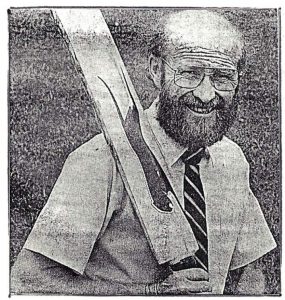
After moving to Maitland from the Central Coast where he had played for many years with the Woy Woy Club, he started playing second grade with the Club in 1972-73 alongside some of North’s’ stalwarts, including Keith Smith, Colin Johnston, and Robin Cotton.
Apart from one season as captain of the thirds in 1978- 79, Mike played second grade up until 1981.
During that time he was their leading run-getter for a couple of seasons and captained the team from 1974-76.
During his first season as captain the team came second last but the following season he led them to the final.
In the Annual Reports, he was described as “playing some stubborn innings” and was acclaimed for his “gully catches” and “brightening up the games with his humour”. His own captain’s reports were laced with some of his “pearls of cricket wisdom” that were to become one of his trademarks over the years.
In 1981-82 he had a season in first grade opening up the batting, but then apart from a few further games in first grade, he reverted to second grade up until 1987, captaining the side from 1985-87.
Following the amalgamation, he played third grade from 1987-91. lt was during this time that he celebrated his 250th game with the Club in 1990 by scoring 41 runs and taking 8 wickets with his “lofted tweakers” in a match against Weston Workers at Bolwarra.
In the later stages of his career, he moved down to fourth grade. From 1992-2001 he captained the side with considerable success and was particularly proud of his record of getting the fourths into the semis each season (with the exception of 1998-99), winning the minor and major premiership in 1992-93, the minor premiership in 1995-96 and the major premiership in 1996-97. 0ne of his courageous efforts was in the 1992-93 final where he suffered a broken hand during the match but batted one-handed to hold up one end and help the side get the necessary runs for victory.
In captaining the lower grades Mike showed a remarkable capacity to turn “a rough side of triers into a team of winners” and to overcome the handicap of frequent changes in team members and shortage of players. Even when his bowlers were “being belted around the ground” unmercifully he never lost his “eternal optimism” and would encourage his team with comments such as: “Come on – we’re on top!”
During his long association of more than thirty years with the Club, Mike was a very active and loyal Club man. He served on practically all positions in the Club’s administration, including Assistant Secretary, Assistant Treasurer, Selector, Secretary, Treasurer, Vice-President, and President. As a fitting reward for his services, he was made a Life Member of the Club.
Paul McLaughlin
Paul McLaughlin (“Bossman”) was another “captain courageous”.He started his senior career with the Bolwarra Club after some limited experience in the juniors.
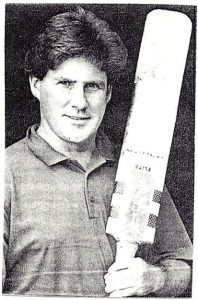
Following the amalgamation, he played mainly in third and fourth grade, apart from a few games in seconds. He captained the fourth grade in 1991-92 and the third grade from 1993-96. During those seasons the thirds won the minor and major premiership in 1993-94 and the minor premiership in 1994-95. After a break, he led the thirds in 1999-2000 and the fourths in 2001-02 to their respective finals.
Paul’s approach to the game was aptly summed up by his third grade captain, Bruce Leary, in 1987-88: “A driving player in the field who just loves to succeed. An opposing captain’s nightmare with a textbook shot followed by an on-drive over point followed by something in between. A very quick runner between wickets who always keeps the scorers busy.”
Paul’s first team report as captain of fourth grade in 1991- 92 also reflected his attitude to the game: “By the end of the season fourth grade had changed from a few blokes getting together for a Saturday arvo hit, to a team of mates wanting to do their best. The thing I will always remember about this side is its spirit and attitude, which can be boiled down to always be competitive, but more importantly, always enjoy the game!” One of Paul’s best seasons was in 1994-95 when he scored 344 runs and took 13 wickets in third grade. Included in his batting performances for that season were two consecutive centuries – his maiden century of 120 against Thornton at Thornton followed by 100 against Tenambit Morpeth at Black Hill. ln 1993-94 he also played a major part in the finals, scoring 40 not out against Weston Workers in the semi-final and 40 against Tenambit Morpeth in the final.
Apart from his captaincy responsibilities, Paul was very much involved in the administration of the Club. He served two terms as Club President in 1996-97 and 2000-01 and took on the role of Secretary in 2002-03.ln recognition of his services both on and off the field he was made a Life Member in 2002-03.
Michael Cantwell
Michael Cantwell played his early cricket with the Lochinvar Club in the sixties. After being graded first grade, he played a season with Black Hill in 1970-71.
After quite some time out of the game, he resumed playing with Northern Suburbs. In 1989-90 he took on the captaincy of the C3 grade team and led them to a major premiership win.
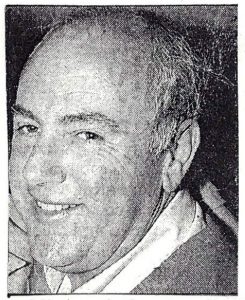
Following the introduction of a fifth grade in District cricket, he captained the Club’s fifth grade team for three seasons from 1990-93 with considerable success.
They won the minor premiership in 1990-91 and made the semi-finals in each of the three seasons.
Michael played an important part in that success with his own batting but his greatest asset was in the guidance that he gave to the juniors in these teams. Included among these at various stages were his three sons – Adam, Chad, and Jacob.
As the 1989-90 Report noted: “Michael (Captain Mick) Cantwell – True mentor of the junior players with just the right balance of discipline and leadership. Michael consistently played down the order to give the boys the exposure to a little pressure and the chance to prove themselves.”
Using an extended nautical metaphor, the 1990-91 Report summed up Michael’s contribution as follows: “Captained the ‘good ship 5th grade’ in a most exemplary fashion steering us to a minor premiership. The cap batted well as captains should and was disappointed when we were becalmed in the semi-final.”
Apart from looking after the juniors, Michael did a lot of work for the Club, particularly in the organisation of social functions, including the “Black and Red Balls”. He also served as a member of the Association’s Board of Control from 1990-93.
Lawrie Ireland
Lawrie Ireland came to the Club in 1993-94 after having previously played for Tenambit-Morpeth and after having been involved with Northern Suburbs juniors.
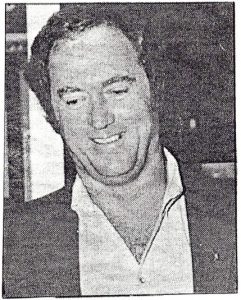
In his first season with the Club he scored 375 and was one of the “guiding lights” of the fifth grade, assisting the captain, David Dyson, with the management of the young team. David paid him the following tribute: “No doubt the class cricketer in this young team, Lawrie inspired the younger lads with numerous half-centuries throughout the year. We all enjoyed batting with the ‘old fellow’ as Lawrie doesn’t like to run a lot. A great aid to this young captain, always willing to give advice.”
Lawrie took over the captaincy of the fifth grade in 1994-95 and along with Tony Briscoe, Merv Sayers and Will Callinan molded the young team, which included three players only 12 years old, into a match-winning combination that defeated three-time winners, Thornton in the final.
He followed up this success by leading the fifth grade to the final in the following season, only to be beaten by Thornton. Lawrie himself had a very successful season scoring 368 runs, including a century in the first match.
In 1996-97 the fifths, under Lawrie’s captaincy, won the minor premiership but again suffered the disappointment of losing the final, this time to Eastern Suburbs. Lawrie improved on his previous season’s performance by scoring 443 runs.
The following season Lawrie once again led the fifths to the final, only to lose to City United. He continued to show good form with the bat, heading the District aggregate with 444 runs, including a century against Tenambit-Morpeth.
Lawrie took great satisfaction in seeing the younger players under his charge improve and go on to play in the higher grades. As he wrote in his 1995-96 Report: “26 players took the field during the season, with 9 players under the age of 15 years playing a combined total of 67 games during the season. This is the purpose of fifth grade, to blood young cricketers and teach them to love the game and to be groomed for the higher grades in the future.”
Pavilion and Ground Improvements
This period saw some further pavilion and ground improvements.
Mainly due to the efforts of the Maitland Rugby Club the new Club room was refurbished in the Lorn Park pavilion. As its share of the cost, Northern Suburbs Cricket Club contributed half of the expenses with $8000 being paid back over four years, together with a yearly maintenance fee of $500. The final debt was repaid by the end of the 1991-92 season.
The Club further benefited from the development of Marcellin Park and its facilities as the headquarters of Maitland Rugby Union. This meant that Lorn Park had much less “wear and tear” during the football season and the cricket Club had greater use of the pavilion as its social venue and club centre.
In 1994-95 there was an extensive $12000 redevelopment of the oval and wickets. The three centre wickets were returfed and a new irrigation system was installed. Maitland City Council paid for the returfing while the irrigation system funding came from a Sport and Recreation grant, Northern Suburbs Club, the Oval Board and Stockers and Partridge of Paterson.
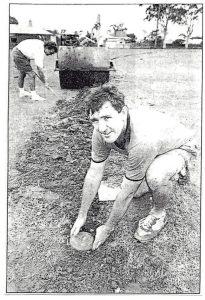
A set of wicket covers was also purchased following the Association’s decision to make covers compulsory for all first grade grounds. This proved to be of considerable benefit in allowing matches to be played that otherwise would have been washed out.
Reaching the Century
On the way to the century milestone, the Club enjoyed mixed fortunes, though success was never far away.
In the 1997-98 season, the Club had considerable success winning the Club Championship, the first grade minor premiership, and the second grade minor and major premierships, while four of the five teams qualified for the semi-finals and three progressed to the finals.
The following season – 1998-99 – the Club was affected by the loss of a number of players and failed to win any premierships. Only the first and second grade teams managed to qualify for the semi-finals. The second grade lost to Eastern Suburbs in the semi-final, while the first grade in a repeat of the previous season’s final, lost to Raymond Terrace after being bundled out for 81.
The 1999-2000 season saw further disappointment. The first grade team failed to qualify for the semi-finals when it lost its last competition match against Raymond Terrace and slipped from second to fifth position. Three of the Club’s other District teams – second, third, and fourth grades – all progressed to the finals only to lose their matches.
In 2000-01 the first grade team again missed out on the semi-finals, finishing seventh in the competition. The thirds and fourths both qualified for the semis but had their major premiership hopes dashed when rain completely washed out the matches.
The 2001-02 season saw a revival in the Club’s fortunes with first, second, and fourth grades all qualifying for the semi-finals. First grade defeated minor premiers, Eastern Suburbs, in the semi-final, but went down to Weston Workers in the final; second grade defeated minor premiers, Raymond Terrace, in the semi-final and then went on to take out the major premiership by defeating Eastern Suburbs in a close final; and fourth grade was knocked out in the semi-finals when they lost to Eastern Suburbs.
In 2002-03 the Club was strengthened by the addition of former City United players, Mathew Hodges, Troy Burton, and Shayne Rumbel, and by former Western Suburbs player, David Seers. With this added depth the Club enjoyed success in both of the top grades – winning the minor and major premiership in first grade and the major premiership in second grade.
Under the captaincy of Matthew Wilks the first grade team, after losing its first match, put together a winning sequence of thirteen matches to win the minor premiership by a clear margin and then went on to defeat the former major premiers, Weston
Workers, in the semi-final and Raymond Terrace in the final. The second grade, skippered by David Ward, came from the fourth position to defeat minor premiers, Eastern Suburbs, in the semi-final and Raymond Terrace in the final.
This double success was all the more meritorious as at one stage it looked as if neither team would be able to contest the semi-finals. This followed a controversial Association ruling that both teams should be debarred because of the Club’s late payment of an account. However, following a series of appeals and considerable publicity the decision was overturned and the two teams were able to play in the semi-finals, though a week later than originally scheduled.
Two Massive Scores
During the 2001-02 season two Northern Suburbs’ teams recorded massive scores – one in first grade and the other in second grade.
In a first grade match against City United at Robins Oval on 20th October 2001 Northern Suburbs hit up 426 – one of the highest post-war first grade scores! Kurt Humphreys top-scored with an unbeaten 185 and Brett Taylor belted 118.
On 16th February 2002, Northern Suburbs’ second grade team piled on the runs to score a formidable 505 against Thornton Park at Thornton No 2. Centuries were made by Ben Ireland (126), Jason Brazier (120), and Phil Carter (115).
A Winning Double!
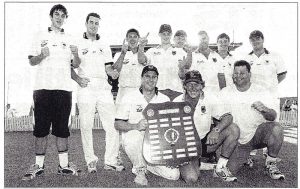
Front: Matthew Wilks (Capt.), Phil Callinan, Brett Taylor
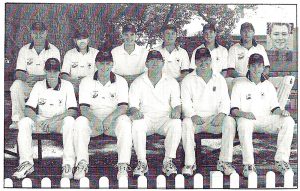
Front row: Trent Lantry, Shayne Rumbel, David Ward (Capt.), Mark Peno, Joshua Callinan,.
Inset Top: Daniel Cant
Rod Faulkner
Rod Faulkner came to play with Northern Suburbs Club in 1989-90 after having previously played with Largs in the Club competition. In the 1987-88 season with Largs, he had been named the Association’s Club Player of the Year after taking 53 wickets and scoring 444 runs. In the following season in A grade, he took a further 52 wickets at an average of 8.4.
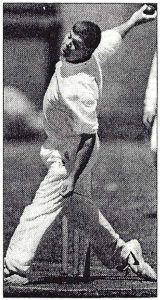
As an opening bowler in Northern Suburbs’ first grade team, Rod made a very successful transition from Club to District cricket.ln his first season he headed the District bowling aggregate with 34 wickets at an average of 16.9.
For the next fifteen seasons, he continued to open the bowling in first grade and was a consistent performer.
In 1992-93 he topped the Club’s bowling aggregate and average with 23 wickets at 19.8 and in 1995-96 and 1998-99 he topped the District bowling aggregate with 24 and 42 wickets respectively.
Some of his best bowling performances were recorded in the 1997 -98 season when he headed the District averages and was second in the aggregate with 35 wickets at 11.38.ln a match against Weston Workers at Lorn Park at the beginning of the season he finished with the remarkable figures in the first innings of 7-7 off 9.5 overs with 7 maidens and followed this up with another 3 wickets in the second innings to give him a haul of 10 wickets for the match. ln another match against Thornton when Northern was defending a modest total of 142, he played a major role in dismissing Thornton for 114 by taking 7-40 off 19.3 overs.
Rod also represented Maitland in the Colts competition and was a member of the John Bull Shield team for five seasons from 1990-96. During that time he was a member of three John Bull Shield winning teams and in 1992-93 was the inaugural winner of the Brad Shone Memorial Shield for Representative Player of the Year.
In 1990-91 he represented Hunter Valley in the Under 24 Zone Trials at Armidale and was a member of the Hunter Valley senior team that competed in the Tooheys Country Cup Zone Trials at Gunnedah.
A solid Club man, Rod could always be relied upon for a wholehearted effort, whether it was opening the bowling or working for the Club. He was instrumental in a sponsorship recruitment drive for the Club and in helping to install the underground sprinkler system on Lorn Park. In recognition of his contribution to the Club he was made a Life member in 2000-01.
Dominic Wilkinson
Dominic Wilkinson was a Norths junior who came up through the lower grades. One of his best early seasons was in 1989-90 when he scored 401 runs in C3 grade and was named the Association’s Player of the Year in that grade.
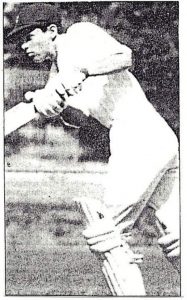
A right hand opening batsman with a very sound technique, Dominic was promoted to first grade in 1991-92 after making a promising start to the season in seconds where he scored 213 from 5 innings, including 145 not out in the first match. From his first five innings in first grade, he scored 121 runs and showed that he had the talent to handle the step up to the higher grade.
In 1992-93 he performed consistently to finish with a batting aggregate of 336 runs.
Among his best efforts was a fighting innings of 80 in the losing semi-final against Raymond Terrace. For the next two seasons, he left the Club to play with University in the Newcastle competition.
In 1995-96 he returned to the Club and resumed his opening batting position. In his first season back he scored 335 runs, including 110 not out in a first round match against Eastern Suburbs.
The following season in a premiership-winning team he had a disappointing season scoring only 187 runs, but played a sound opening innings of 39 in the final.
He showed a marked improvement in the 1997-98 season scoring 567 runs at an average of 47.25.0ne of his best efforts was an unbeaten 149 scored against Weston Workers at Kurri Central. ln the 1998-99 season he again showed good form, scoring an aggregate of 449 in all matches, including two centuries (120 against Raymond Terrace and 101 against Western Suburbs).
At the end of the 1998-99 season, he went to England and this cut short his cricketing time with the Club.
During his time with Norths Dominic had an impressive representative record. He was selected for the Country Boys Coaching Class and was in the Hunter Valley Under 17 team.He also played for Maitland Colts from 1991-93 and went on to represent Hunter Valley Colts at the J S White Carnival at Tamworth from 1991-93.
On his return from Newcastle, he represented Maitland in the winning John Bull Shield teams from 1995-97. He was also named Maitland’s Representative Player of the Year in 1995-96 after scoring 167 runs, including a fine century against Newcastle City & Suburban.
In 1995-96 he had a very successful Under 21 Carnival at Tamworth and was selected in the Central North team and in the Emu Colts team that toured NZ. On the tour, he played an important role in the Emu Colts “Test” and “one day” victories over the Canterbury Kiwis.
Apart from his cricket talents, Dominic also showed that he was a gifted compere in the way that he took on the role of Club Captain from 1997-99 and handled the traditional after-match captains’ reports sessions in the pavilion on Saturday nights.
Johnny Clifton
A Northern Suburbs player who became well known for his unusual way of celebrating scoring runs or taking wickets was John Clifton.
In a second grade match against Weston Workers at Kurri Central during the 1997-98 season, John had good cause to celebrate and show off his characteristic acrobatic trademark – a handstand!
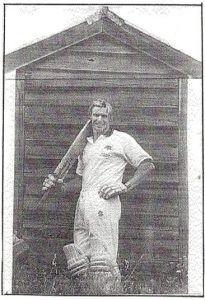
He came to the crease with his side in trouble at 4-35 chasing Weston’s 153. When he left he had belted 113 from 31 scoring strokes – a knock which included 13 sixes and 4 fours!
When he reached his 50 and then his 100, instead of giving the traditional salute to his teammates by raising his bat and pointing it towards the pavilion, he did a handstand in the middle of the pitch – no mean feat when clad in pads!
Perhaps he could attribute his rapid-fire century to a change in bat. A fortnight before he had broken his old one when he clouted a six at Lorn Park.
Matthew Wilks
Matthew Wilks was a talented all-rounder who played his junior cricket with Norths.
In 1987-88 he made rapid progress through the senior grades going from A grade to thirds and then to seconds. He was described as “another up and coming young bowler who will definitely go on to first grade”.
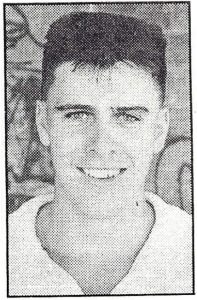
The following season he opened the bowling in second grade and finished as the team’s leading wicket-taker with 25 wickets. In the semi-final against Thornton, he took 5 wickets and was named the Club’s Junior Player of the Year.
After starting the 1989-90 season in second grade, he was promoted to first grade. The following season he began to show his all-round potential by scoring 227 runs and taking 9 wickets.
He then decided to try his luck in Newcastle, playing one season with Merewether and another with University.
He returned to the Club in 1993-94 and was still playing first grade ten seasons later. Following on two bleak seasons from 1992-94 when the University and Norths’ teams that he played for failed to win a single match, his fortunes changed for the better. He captained the 1995-96 team to a minor premiership win and after coming back from a serious shoulder injury was a member of the 1996-97 team that won the first grade minor and major premierships.
In 1997-98 under the captaincy of Paul Dyson, he was a member of another Norths’ first grade team that won the minor premiership, only to be defeated by Raymond Terrace in the final. The following season he resumed the captaincy and after finishing second in the competition, led the first grade team to another final, only to suffer the further disappointment of another loss to Raymond Terrace.
During the off-season in 1999, he underwent an operation in an attempt to overcome a back problem and this put him out of action for most of the 1999-2000 season. After scoring a century in a “comeback match” in second grade, he returned to first grade for the last two games of the season.
In 2000-01 he was back captaining a young first grade team and showing that he had lost none of his batting skills by scoring 425 runs for the season. ln 2001-2002 he was again captain of the first grade team that overcame minor premiers, Eastern Suburbs, in the semi-final only to continue his “run of outs” in finals by losing to Weston Workers.
The following season – 2002-03 – he captained the first grade team “all the way” to a convincing minor and major premiership. His own contribution with the bat was 454 runs including a century against City United and 90 against Tenambit-Morpeth.
In 1994-95 Matthew had headed the District bowling averages with 22 wickets at 13.4. Unfortunately, the back and shoulder injury that led to his operation hampered his bowling career and he had to rely mainly on his batting to hold down a first grade spot. A hard-hitting left-handed batsman, he played some very useful innings – none better than his 89 not out against Raymond Terrace in 1995-96 in a one-day match that Norths won by one run. He scored his first century, an unbeaten 120 not out in a match against Western Suburbs at Lorn Park in the 1997-98 season.
One of his powerhouse hitting displays was shown in Norths’ Ten Over competition
at Lorn Park in 1997-98 when he hit 11 towering sixes in the final to score a rapid-fire century.
Matthew was very successful at the representative level. Prior to going to Newcastle, he represented Maitland in the Colts competition and on his return, apart from a few matches out through injury, was a regular member from 1993-99 of Maitland’s successful John Bull Shield team. In 1998-99 he had the honour of captaining the John Bull Shield team that won the competition. ln 1994-95 he took 13 wickets in the John Bull Shield competition, including a hat-trick against Newcastle City and Suburban.
He represented Hunter Valley Colts and in 1993-94 was chosen in the Emu Colts team that toured NZ and in the North West Zone Colts side that competed in the Combined Zone Carnival at Cowra. From 1993-97 he was a member of the Hunter Valley senior side that participated in Zone Trials at Gunnedah, Narrabri, and Scone, and from 1995-97 was chosen in the Central North teams that competed in the Country Cup Northern group Carnivals in Newcastle and Narrabri.
Matthew also gained experience in playing under English conditions. In 1988 he toured England with an invitation Under 17 Hunter Region team and in 1997 went back to England during the off-season and played with Longsight in the Lancashire League competition.
Matthew’s talents were not confined to the cricket field – he was largely responsible for “launching the Club into cyberspace”. With the assistance of Matthew Holwell, he helped set up a website for the Club which provided a wide variety of information about the Club’s activities, players, and history.
Sports Medal Awards
Northern Suburbs Club had the distinction of having three of its Life Members awarded Australian Sports Medals during the 2000-01 season. The recipients were
Bruce Leary, Alan Mudd, and Lindsay Wood.
The special medals were produced by the Commonwealth Government and presented as recognition of current and former sports participation and to those who have contributed to the sport through the provision of support services to sport.
The Year in Review
One of the identities associated with Norths Club in recent years has been Hunter Calder.
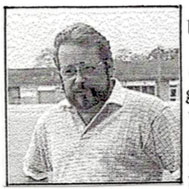
As a Club sponsor through the Lorn Learning Centre, Chairman of the Lorn Recreation Board, and a keen follower of Norths’ home games and the Club’s fortunes, Hunter became very closely associated with the Club.
On Presentation Nights he brightened up proceedings with his “Year in Review” which provided a humorous insight into the “on and off-field exploits” of some of the Club members. As Hunter outlined the particular award, the member was required to stand and “take his medicine”.
Hunter’s “way with words” is shown in the following sample from the 1998-99 Presentation Night:
Longest Hit of the Year – Brett Taylor at Lorn Park. On his way to compiling a splendid 171 runs. Squizzy increased the insurance premiums on all the surrounding dwellings by leaving a calling card on most of them. None more so than on the Madden domain previously believed to be impervious to hailstones as large as cricket balls. Upon hearing the thump of Squizzy’s ball on her roof, the lady of the house ran out screaming, ‘The house is falling!’ It is reliably reported that local residents have invested in bicycle helmets for use when gardening on Saturday afternoons. Never mind about the neighbours Squiz, just keep raining cricket balls next season!”
Tony Fort
Tony Fort came to the Club in 1994-95, by which stage he had an impressive cricket background and a wealth of experience.
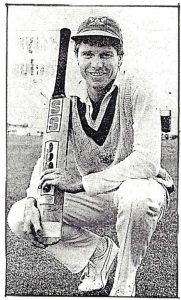
After playing first grade in the Maitland competition in the eighties with City United and Tenambit-Morpeth, he had moved on to play with University and Hamilton- Wickham in the Newcastle competition. Then after three seasons with Northern Districts in the Sydney competition, he returned to play in Newcastle with Stockton. During the off-season in 1990, he also played for the Gowerton Cricket Club in Wales.
At the schoolboy level he had represented Hunter Region and CHS No 1 and had toured with the Emu Colts and the Old Collegians.
ln 1988-89 he had been selected for Australian Country and State Colts following an outstanding performance for NSW Country at the interstate Country Carnival at Bunbury in WA, where he won the Bradman Trophy for the Outstanding Batsman of the Series and two other awards for Player of the Series and NSW Player of the Series.
He also had captaincy experience at the senior level in leading the State Colts and NSW Country teams.
He was therefore a valuable acquisition when he took on the role of Club coach and first grade captain with Northern Suburbs in 1994-95.ln that first season he scored 356 runs at an average of 35.6 to top the Club batting average.
The following season he stood down from the captaincy but had a very successful season with bat and ball, heading the District batting average with 374 runs at an average of 62.3 and taking 20 wickets with his off-spinners. In the final against Western Suburbs, he played an impressive innings of 65 not out, only to run out of partners within sight of victory.
In 1996-97 he played a major role in the success of the first grade in winning the minor and major premierships. He scored 414 runs, including a century against Thornton. Then in the final against Thornton, he played “one of the best pressure innings seen in Maitland cricket for some time” to score 94 not out and steer his side to victory.
The next season he scored 363 runs and followed this up with another successful
season in 1998-99, scoring 595 runs in all matches, including three centuries, and taking 19 wickets.
His last season with the Club was in 1999-2000 when he again headed the Club’s first grade batting aggregate and average with 518 runs at an average of 38.9. He scored two centuries during the season and was unlucky to miss out on a third when he made 98 against Eastern Suburbs.
On his return to Maitland in 1994-95 he resumed playing in the John Bull Shield competition and captained the Maitland team for two successful seasons before retiring from representative cricket. In 1994-95 he was named Representative Player of the Year after scoring 380 runs, including a score of 196 against Dungog at Robins Oval.
Paul Dyson
Paul Dyson came to the Club in 1996-97 with a very experienced cricket background.
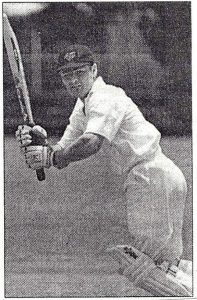
He started playing with City United and then moved on to play in the Newcastle competition with University and Stockton and in the Sydney competition with North Sydney. He also had stints in England in the Huddersfield and Yorkshire competitions.
In 1991-92 he had been selected to play for NSW Country against India and the West Indies, and in the interstate Country Championships in Adelaide. He was also appointed captain of the NSW Country Colts.
A stylish top-order batsman and a handy off-spin bowler, Paul proved to be a real asset to Northern Suburbs.
In his first season with the Club, he took on the captaincy and led the first grade team to a win in the minor and major premiership. His own contribution was 455 runs, including a century, at an average of 50.6, and 11 wickets.
He followed this up with another successful season in 1997-98, leading the team to
another minor premiership and losing a hard-fought match in the final to Raymond Terrace.
Paul topped the District batting aggregate and average with 598 runs at 66.4 and also took 29 wickets. He finished the season with a surge of runs, scoring 136 not out against Eastern Suburbs in the final round, 106 in the semi-final against City United, and 99 in the final against Raymond Terrace. Earlier in the season, he scored a courageous 147 against Western Suburbs at Coronation Oval – a knock which included 15 fours and 6 sixes. Prior to the match, he had withdrawn following diagnosis of a mild form of glandular fever, but when there was a late withdrawal he came back into the side.
Following a successful season with Maitland first grade Rugby Union, Paul took a break from cricket in the 1998-99 season. He returned to play for the Club after the start of the 1999-2000 season but after only a couple of matches retired following an injury.
Back in 1986-87, as a seventeen-year-old, Paul had scored his first century in a John Bull match against Singleton to help Maitland win a place in the final of the competition. On returning to Maitland, he resumed playing John Bull Shield and in 1996-97 captained the Maitland team to a record fifth consecutive win in the competition by defeating Dungog in the final.
Mark Meskaukas
Mark (“Mouse”) Meskauskas came to the Club in 1987-88 after having previously played with Western Suburbs, Maitland City Bowling Club, and Bolwarra.
After some exciting hitting from the “Big Fella’ in second grade, Mark was brought into first grade where his captain, Paul Johns, predicted that “he was a player with a big future”.
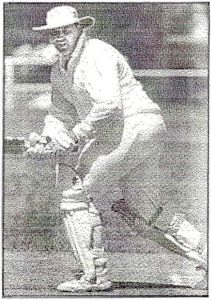
After playing a mixture of first and second grade games in 1988-89, he began to realise his potential the following season in first grade by scoring 236 runs, including a century against Weston Workers at Lorn.
Then after half a season with the Club in 1990-91, he spent the next four seasons playing with Windsor Castle and the George and Dragon Clubs in the A grade competition, where he was successful with both bat and ball.
Returning to Norths Club in 1995-96, he became an established member of the first grade team and took over the captaincy in 1999-2000.
Among some of his best performances in first grade were his 153 not out against Thornton in 1995-96 and his 123 against Western Suburbs in 1998-99. He also played some fine innings in the first grade semis and finals – 60 in the final against Western Suburbs in 1995-96; 37 in the final against Thornton in 1996-97; and 56 not out in the semi-final against City United in 1997-98.
Brett Taylor
Brett Taylor came to Northern Suburbs in 1998-99 after having previously played for Eastern Suburbs. Following his first season in which he scored 437 runs and took 7 wickets in first grade, he was pronounced as the Club’s “recruit of the year”.
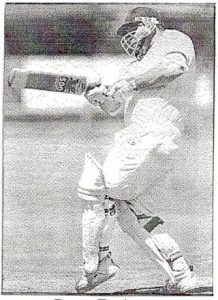
In one of the first grade matches against Western Suburbs at Lorn Park on November 21st, 1998 he played a blockbuster innings when he scored 171 – his first century in first grade. His century, scored off 37 overs and including 19 fours and 8 sixes, was rated as one of the best displays of power-hitting seen in Maitland first grade cricket since the time of the Elliotts. He shared in a 202 fourth wicket partnership with his captain, Matthew Wilks, which broke the all-time previous Norths Club record of 165 set by Wilfred Jarrett and Arthur Watson way back in 1926.
This innings had special significance for Brett in that his mother had died in the preceding week and he had made a special request of his captain to bat at number three so that he could dedicate the innings to his mother.
The following season he struggled to find form but in 2000-01 he “once again proved himself as one of the best cricketers in Maitland” by scoring 353 runs and taking 14 wickets.
He followed this up with one of his best seasons in 2001-02 when he scored 405 runs, including two centuries and three nineties, and took 14 wickets. Work commitments restricted his appearances in 2002-03 but he still played some useful innings including an unbeaten 63 in the first grade semi-final against Weston Workers.
Prior to coming to Norths, Brett had already represented Maitland, Hunter Valley, and the Central North Zone in the Colts. ln 1999-2000 he gained further representative honours by playing for Maitland in the John Bull Shield competition and for the Central North Zone in the Country Cup Carnival at Lismore. ln 2001-02 he was also a member of Maitland’s NRMA Cup team that finished eighth in the statewide competition.
Greg Watts
Greg Watts can aptly be described as “a player for all grades”.
He started his long Club cricket career in 1972-73 with the Black Hill Under 15 Juniors. Showing a lot of promise as a left-arm opening bowler, he was soon playing in the senior ranks, starting with third grade in the same season and then rapidly being promoted to first grade halfway through the 1974-75 season.
He continued to play first grade with Black Hill (later called Bolwarra) Club up until the mid-1980’s. During that time he was a member of the first grade team that won the major premiership in 1975-76, and he recorded one of his best seasons in first grade in 1982-83 when he took 31 wickets at an average of 18.0.
Following the amalgamation in 1987 he gravitated up and down the grades with Northern Suburbs, playing wherever the Club needed him most. Apart from a few “temporary retirements”, he played mainly in third, fourth, and fifth grades, but at one stage in 1991-92 he came back to play most of the season in first grade – at the time it was reported in the press that he was “making his debut”!
In 1994-95 he also captained the second grade team.
Very economical in his bowling, Greg headed the District bowling averages on a number of occasions – third grade in 1989-90 and 1990-91 with 33 wickets at 9.1 and 33 wickets at 10.3 respectively; and fourth grade in 1999-2000 with 21 wickets at 8.0.
A willing Club worker, Greg served in a number of administrative positions. He was Assistant Secretary with Black Hill Club – and at various stages took on the roles of Assistant Treasurer, Vice-President, Chairman of Selectors, and Treasurer with Northern Suburbs. In recognition of his contribution to the Club, he was made a Life Member in 1996.
At the Association level he was a member of the Board of Control from 1997-2000 and in 2000-01 also took on the role of Representative Secretary and Manager of the Maitland Colts representative team.
Bruce Leary, his captain in 1988-89, summed up Greg’s contribution to the Club and the various teams with which he played, in the following way: “Greg is the complete competitor, giving his best for team and Club every week.”
Rick Tully
Rick Tully came to Norths Club in 1990-91 after having played for a number of other Clubs earlier in his cricket career. The Club Report noted that he had “had more Clubs than Jack Nicklaus but (had) finally come home”.
Choosing to remain in the lower grades, he selflessly captained for a number of seasons third and fourth grade teams where he was able to pass on his knowledge and the benefit of his cricket experience to the up and coming players.
He became very active in the administration of the Club and was particularly involved in the organisation of fund-raising and social activities. For many seasons he took on the responsibility of running the weekly Lorn Park Bowling Club raffle and in more recent years organised a number of successful Trivia Nights. Ever mindful of the need to foster young talent in the Club, he was also instrumental in starting a coaching program for the Club’s junior players.
Even when forced to retire from playing in 2000-01 with a serious back injury, he still continued to work enthusiastically for the Club, taking on the roles of Chairman of Selectors and President of the Social Committee. It was fitting that he should be the inaugural winner of the Mark Beavis Memorial Award for Clubman of the Year.
Tony Briscoe
Tony Briscoe began playing fifth grade with the Club in the 1993-94 season. Apart from coming to the rescue of first and second grade for a few games as a replacement wicket-keeper, he was mainly a core member of fifth grade.
His value to fifth grade was summed up by Lawrie Ireland in the captain’s report for 1994-95: “(Tony) is the motivator of the side; the one who considers outright victories as possible after the first wicket has fallen … As the senior player in a young side, Tony was priceless for his enthusiasm and zest for the game. He is a model for younger players.”
Five seasons later Tony had lost none of his enthusiasm as shown in the captain’s report for 1999-2000: “Tony Briscoe – A 14-year-old running around in an older body. Wicket-keeper, opening bat, and part-time bowler.Great team player who loves his cricket and constantly encourages us all in the field.”
Tony was also an active Club member off the field. In the 1994-95 season, he assisted Paul Johns with the curating at Lorn Park and was involved with the returfing of the center square and the installation of the sprinkler system. When John Wilkinson suffered a stroke during the 2000-01 season, Tony stepped in and with the assistance of his two sons, took on curating Bolwarra Oval wicket.
A media personality through his radio and television work, Tony was also the compere at many of the Club’s official functions and Presentation Nights.
Ben Briscoe
Ben Briscoe was one of the youngsters who started playing his senior cricket with the Club in fifth grade and worked his way up through the grades to first grade.
He played his first game in fifth grade in 1993-94 when he was just ten years old.
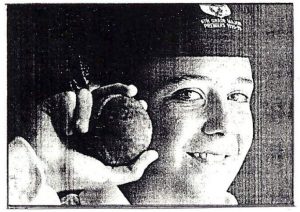
Two seasons later his fifth grade captain described him as a “solid leg-spin bowler” and predicted that he would “become a high-grade player”.
In 1997-98 he was awarded the Club’s Junior Player of the Year Trophy after taking 38 wickets in fifth grade. Promoted to third grade in 1998-99, he took 21 wickets including 5-11 off 7 overs against Raymond Terrace. The following season he mainly played fourth grade, winning the bowling aggregate with 27 wickets at 9.8.
His opportunity to play first grade came in the 2000-01 season. Growing in confidence as the season progressed, he had a very successful first season in the top grade, bowling some very long spells and taking 24 wickets at an average of 24.2. He also represented Maitland and Hunter Valley at both the Colts and senior levels.
However, in the following two seasons he was not able to maintain the same form and had difficulty in keeping his position in first grade.
Tom Briscoe, Ben’s younger brother, also started playing fifth grade with his father in 1996-97 at the age of ten. He soon began to show his promise as a left-arm swing bowler and after taking 32 wickets in fifth grade in 1998-99 was named the Club’s Junior Player of the Year.
After progressing through second and third grades and again being named Junior of the Year in 2000-01 he made his debut as an opening bowler in first grade in 2002-03. During the season he gained confidence and finished off with strong performances in both the semi-final and final.
Tom also represented Maitland in the junior age divisions and at the Colts level and represented Hunter Valley in the Bradman Cup, Under 17, and Under 18 teams.
Ben Ireland was another junior who started playing fifth grade in 1993-94 at the age of eleven alongside his father, Lawrie. The following season he was described as “a talented batsman” and “definitely a higher grade player of the future”.
In 1996-97 he won the Club’s Junior Player of the Year Award after being promoted to third grade for the second half of the season.
By 1998-99 he was opening the batting in second grade and finished the season with an aggregate of 222 runs.
He made a promising debut in first grade the following season by scoring 167 runs from his eight innings.ln 2000,–01 he had become the regular opener in the first grade team and scored 258 runs.
After an indifferent start to 2001-02 in first grade, he spent most of the season in second grade where he scored 257 runs, including two centuries.
The following season he left the Club to play for University in the Newcastle competition.
The Humphreys
Gavin Humphreys, the oldest of the three brothers to play first grade for the Club, started out playing third grade in 1994-95 after having previously played Club cricket with Hunter United.
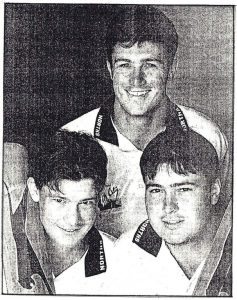
He soon showed his potential by scoring 225 runs and taking 22 wickets to win the Club’s All-Round Player of the Year Trophy.
He made his first grade debut in 1995-96 and for a couple of seasons as an opening bowler and middle-order batsman enjoyed only moderate success.
However, with a change to bowling leg-spin and opening the batting, he established himself in the 1999-2000 season as a valuable first grader, scoring 389 runs and taking 10 wickets.
After taking the next season off, he returned to the fold in 2001-02 and had one of his best seasons scoring 329 runs, including a maiden century against Thornton, and “chipping in” with 7 wickets.
Gavin also represented Maitland and the Hunter Valley in the Colts and in 1995-96 after the Tamworth Carnival was selected in the Central North Zone Colts team.
Kurt Humphreys followed his older brother to the Club in 1997-98 after having played a season in third grade with Eastern Suburbs.
Following a season in a premiership-winning second grade team, he had his first full season in first grade in 1998-99.ln his captain’s words, “he pulled himself up to the standard from ball one with both bat and ball” by scoring 196 runs and taking 13 wickets.
The next season he was affected by injury and “struggled to find form”, finishing with just 94 runs and 11 wickets.
However, in 2000-01 he regained confidence, scoring 459 runs and taking 16 wickets to earn the Club’s Best All-Round Player of the Year Trophy.One of the high points of his season was scoring his maiden century – a chanceless 113 against Western Suburbs under difficult conditions at Coronation Oval.
In 2001-02 he established himself as one of the leading first grade cricketers in the Maitland competition by a further strong all-round performance in scoring 490 runs at an average of 49 and taking 18 wickets. His best performance was an aggressive and hard-hitting innings of 185 not out against City United at Robins Oval.
The following season he made a valuable contribution to the first grade’s premiership success by topping the District bowling aggregate with 28 wickets and scoring 401 runs.
On the representative level, Kurt played for Maitland in the Colts, John Bull Shield, and NRMA Cup teams and represented Hunter Valley at both the senior and Colts levels. In 2001-02 he was also selected in the Central North Zone Colts team that played in the Northern NSW Colts Carnival at Gosford and the following season played for the Central North Zone senior team in the Country Cup competition.
Terry Humphreys, the youngest of the brothers,started off playing third grade for the Club during his first two seasons in 1998-99 and 1999-2000.
After a solid all-round performance in second grade in 2000-01 in which he scored 202 runs and took 15 wickets, he was promoted to first grade the following season. There he joined his two other brothers, Gavin and Kurt, to create Club history – the first time that three brothers had played first grade for the Club in the same team!
Despite his relative inexperience, he took on the difficult task of opening the batting and showed that he had the talent to make the grade. Among his best efforts in 2001-02 was a half-century against Weston Workers in the last competition round and determined innings of 26 against the same team in, the final.
In 2002-03 he further consolidated his position in first grade by playing some solid opening innings and picking up wickets with his spin bowling. ln the first grade final against Raymond Terrace he scored 43 in a vital partnership with his brother Kurt to put his side in a winning position.
Patrick Lynch
Patrick Lynch was a newcomer to the Club in 1999-2000. He had previously. played for Tenambit-Morpeth and had shown considerable promise in the junior ranks as an all-rounder.
Unfortunately, Patrick suffered from back problems which severely restricted his fast bowling and limited his appearances in first grade during his first two seasons with the Club.
However, in 2001-02 he “came .into his own” with the bat and put in some strong hitting performances, scoring 213 runs for the season.
One of his best efforts was in the semi-final against Eastern Suburbs where he scored 40 in a vital partnership with his captain, Matthew Wilks, to bring victory to Norths.
He continued his good form with the bat in the 2002-03 season and played a number of match-winning innings, including 53 against Weston Workers and 81 against City United.
Damien Frize
Damien Frize was another talented youngster who made his way up through the grades to play first grade.
He started playing fourth grade in 1999-2000 as a fourteen-year-old. Batting at NO.3 he scored171 runs and was named Junior of the Year. The following season after progressing to second grade and scoring 202 runs, he was awarded the trophy for the Club’s Most Promising Under 16 Years Player.
In 2001-02 he notched up his first century with an unbeaten 134 in a second grade match against City United at Lorn Park when he figured in a 253 run partnership with Shaun Leary. This earned him a middle-order batting position in first grade for most of the remainder of the season.
During the 2002-03 season, he showed a lot of promise with a number of valuable innings in first grade but unfortunately was unable to complete the season because of his commitments with the Newcastle Knights’ Jersey Flegg team.
In 2001-02 he represented Hunter Valley and Central North in Under 17 teams and the following season captained the Hunter Valley Under 18 team.
Justin Lantry came to the Club in the 1999-2000 season after having previously played with Largs in the B1 Club competition.
He started the season “in a blaze of glory with unbeaten half-centuries in the first two games in second grade” and won the Club’s Rookie of the Year Award.
The following season he was given his chance in first grade and scored 106 runs in six innings. However, in 2001-02 he struggled for form and went back to second grade in an effort to regain his confidence.
In 2002-03 he mainly played second grade but returned to first grade for a few matches until a broken arm put him out of action. However, he finished the season on a high note by scoring a match-winning 68 in the second grade final against Raymond Terrace.
Justin also represented Hunter Valley in the Under 18 team in 1999-2000. Some of the other youngsters who have begun to make their mark in the higher grades and on whom the Club’s future strength will depend include Trent Lantry, Josh Callinan, Nathan Smith, and Daniel Cant.
Two Comebacks
The 1997-98 season Saw the return of two former top representative players – Peter Rawling and David Johnston – who had previously played with the Club in their early careers.
Peter Rawling, a former Emu Colt, had played first grade with the Club in the 70’s, and early 80’s before transferring to Thornton. After a break from cricket for a number of seasons, he returned in 1997 to the Club where he had started his career.
Playing in fourth grade he had a very successful season scoring 501 runs and won the District award for Fourth Grade Player of the Year.
David Johnston, a former Sheffield Shield player, made a comeback after a seven-year break to play with his old club where he had started playing first grade thirty years before.
Unfortunately for David and the Club, his comeback was to be short-lived. In his very first match against Raymond Terrace, he ruptured an Achilles tendon putting him out of action for the rest of the season and bringing an end to his cricket career. Ironically, the injury was a repeat of the one that he had suffered in the other foot two years before when playing in a social Ten Over competition match.
A Family Club
Over the years Norths Club has been known as a family Club – some might even say that it was “one big family”!
There have been many instances of sons following in the footsteps of their fathers through the various grades – the Lindsays, Johnstons, Wolstenholmes, Rawlings, and Mudds – to name just a few.
There have also been numerous cases of fathers playing in the same team as their sons. Norths’ fifth grade in the 1999-2000 season typified this family connection as the team included four father-son combinations in its ranks as seen in the photo below.
Not only was this a great experience for the fathers and sons to be playing in the same team, but it was also an ideal way for the “older fellows to be teaching the younger guys coming through.
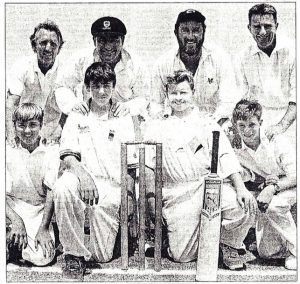
Left to Right Front: James Eagleton, Tom Briscoe, Matthew Ireland, Joshua Callinan
Two Untimely Deaths
Northern Suburbs Cricket Club suffered a sad blow during the 2000-01 season with the untimely death of Mark Beavis.
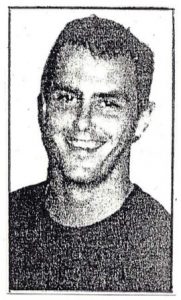
Mark, aged only 26, died on 8th February 2001 after injuries suffered in a rail work accident near Grafton.
A tall, lanky fast bowler, Mark had been a member of the Club since 1992 and had made his way up through the cricketing ranks to play second grade.
Widely respected within the Club, “Beavo” was a popular figure both on and off the field.
He was described by his captains as “a pleasurable young bloke” and as a player who has “a great heart and is committed to his team and club”.
To honour his memory the Club renamed the trophy for Clubman of the Year the Mark Beavis Memorial Trophy.
There was a further sad loss to the Club in June 2002 with the tragic death of Tony Purcell at the age of 31.
Tony had played with City United and Weston Workers before coming to Northern Suburbs Club in 2000-01.
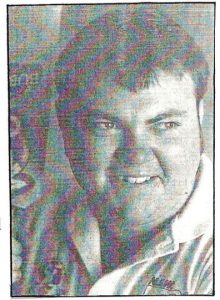
In his first season with the Club, he took on the roles of wicket-keeper and opening batsman in first grade. He proved to be a valuable asset to the team by scoring 330 runs and by his enthusiastic encouragement of the team from behind the stumps.
In the following season, he was a member of the Club’s second grade team that won the major premiership.
He was also a long-time indoor cricket representative and referee at Maitland Indoor Cricket Centre at Rutherford.
Although a fierce competitor, Tony was well-liked for his fun-loving approach to sport and was always ready with a friendly jibe and a joke to lighten the mood of any game.
A Trio of Top Administrators
The success of any Club depends not only on its players but on the strength of its administrators. Norths Club has been fortunate over the years in having many outstanding administrators who have given the Club strong leadership and sound organisation.
In recent years three members who have given great service to the Club in this area have been Bruce Leary, John Wilkinson, and Geoff Searle.
Bruce Leary
Bruce Leary began playing first grade cricket in 1961 with CYMS in Dubbo where as a fourteen-year-old he played alongside his father. Two years later he moved to Sydney to take up his first job as a technician in training with the PMG. He did not begin playing cricket again until he moved to Maitland in 1974.
How he became associated with Norths is best explained by Bruce himself:
“It’s now history that I picked up a hitch-hiker at Lochinvar (1974) and drove him home to Maitland. During our trip, he spoke of the cricket club he played for and the people in that club. ln his mind there were no other clubs and no other people – he encouraged me to play cricket with his club, and that’s the beginning of my affair with Norths (Hitch Hiker’s Name – ‘Iron Mike’ Hopkins).”
In his first season with Norths (1975-76) Bruce played second grade under the captaincy of the “hitch-hiker” Mike Hopkins. The Report noted: “Club newcomer Bruce Leary proved himself a very capable cricketer with a string of handy scores. In fact, Bruce had five not-outs in a row. Bruce was also a great asset as wicket-keeper going from strength to strength.”
It did not take long for Bruce to show his leadership qualities and commitment to the Club – the following season he took on the job of Assistant Secretary and captained the second grade team.
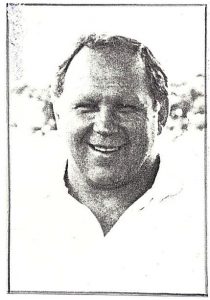
He continued to play second grade as wicket-keeper and opening bat up until the early eighties. One of his best innings was in 1979-80 when the left-hander “blazed away” in typical hard-hitting fashion to score 90 against GUOOF-City. He also becomes involved in coaching and managing the Club’s junior teams in the Saturday morning competition and in 1981-82 served as Club Treasurer.
By 1984-85 he was down in third grade, captaining the team and playing alongside his second eldest son, David. He continued to play third grade up until 1988 and had the distinction in 1987-88 of being “the first Northern Suburbs’ captain to lead a team to the semi-finals”.
In 1988-89 – one year after the amalgamation – Bruce took on the position of President. It was a position in which he was to serve with great distinction, guiding the “newly formed Club” through some of “its teething problems” and inspiring Club members with his energy, drive, and enthusiasm.
Although Bruce spoke at times in the eighties of retiring from playing cricket and “joining the Muppets”, he continued to play up until 1999, making a number of “comebacks”.He captained the A grade team in 1988-89 and after that even though he did not play regularly, if ever a team was short, no matter what the grade, Bruce was there ready to fill in and even don the gloves if needed.
Bruce’s involvement with the Club was a real family affair. His three sons, (Shaun, David, and Adam) were all talented cricketers who at various stages played first grade and scored centuries for the Club. His wife, Gwen, and his two daughters (Bronwyn and Megan) were also very active supporters of the Club and involved in the organisation and catering for many a Club B-B-Q and social function.
In bidding farewell in his eighth and what was then thought to be his final President’s Report in 1996, Bruce wrote: “After twenty-one years in the Club having served as President, Treasurer, team captain, and chief cook and bottle washer, I believe the time has come for me to hand over the baton. The friends that I have made at Norths and through cricket have been the highlight of my innings, and while many are able to talk of great cricket feats, I can talk of great cricket mates.”
As it turned out, Bruce “answered the call” and “took up the baton” again to serve as President from 1997-2000 when the Club had difficulty in filling the position and for a further term in 2002-03. During this extended period, he continued to show the same enthusiasm and commitment that had been characteristics of his earlier years as President.
In recognition of his services to the Club Bruce was made a Life Member. When players return to the pavilion they are also able to look up and see Bruce’s photo and a sign above the bar that reads “The Bruce Leary Bar” which will remind them of someone “who gave of their best to the Club”.
John Wilkinson
John Wilkinson was another who gave tremendous service and commitment to the Club.
He became associated with the Club after being involved for a number of years with the Bolwarra-Lorn Junior Cricket Club, where his two sons, Dominic and Justin, started playing junior cricket. John coached junior sides and also held the position of club Secretary during his years with the juniors.
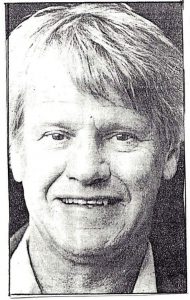
His first mention with the senior Club appears in the 1987-88 Report where he was thanked for his “efforts in coaching the junior boys in the C grade competition”.
His captain, Jimmy Steinerts, also noted that “with courage and stubbornness, Wilko showed that it is possible not only to frustrate opposition bowlers, but that runs could be scored as well”.
He continued to be C grade’s “guide and mentor” for another two seasons, encouraging the younger players and “steadily developing into a specialist fielder, umpire and transporter of young cricketers”.
From 1990-2001 he served with distinction in the demanding role of Club Secretary and after that, despite some health problems, stepped in and took on the position of President.
At the end of 1990-91- John’s first season as Secretary the President, Bruce Leary, paid him the following compliment: “John Wilkinson as Secretary has been a delight to work with. He is no doubt the most organised man I have had the pleasure- to work with within the cricket Club. John has had a great influence on our Club this season and I fully appreciate the workload he has carried not only for the senior club but also the junior club. J.W. – gentleman, scholar, and mate … I salute you.”
John gave up playing regularly but still helped to look after the fifth grade team and was available to fill in, wherever and whenever needed. The fifth grade Report of 1991-92 described him as “our manager and leading umpire” who “when called on to bat or bowl (usually in a crisis) – produced the goods”. In 1993-94 he even played in a first grade game and delighted later on in recounting that he remained 1 not out and that this was probably the first occasion that a father had followed in his son’s footsteps into a Norths’ first grade side.
Apart from the time taken up with his duties as Secretary, particularly in filling teams with replacements after last-minute withdrawals, John, with the help of his two sons, also took on the role of curator at Bolwarra Oval. ln 1994-95 when the Club was in dire trouble trying to find a curator for Black Hill wicket, John stepped in and in his quiet way took on that job as well.
As in the case of Bruce Leary, John’s involvement with the Club was very much a family affair. His two sons, Dominic and Justin, played for the Club while his “long-suffering wife” Pauline was a great support, answering an interminable string of phone calls, following the progress of her two sons, scoring and helping with the organisation of numerous Club functions.
Geoff Searle
Geoff Searle also became involved with the Club through his early association with the Bolwarra-Lorn Junior Cricket Club, where he served six years as Treasurer.
A remarkable aspect of his involvement was that he did not play cricket himself.
However, in 1991-92 he took on the role of Manager of the first grade team. As manager, he looked after the details that made the job of the captain so much easier – attending to the scoring, collection of money, and countless other matters. Captains who had the benefit of his services were very appreciative of “his tireless work” and the load that he took off their shoulders.
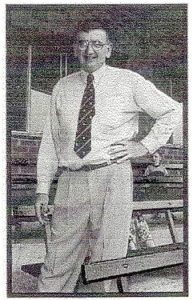
By 1993-94 Geoff was still first grade Manager and was taking an active role in the Club’s administration as the Senior Vice-President. In that season he was awarded the Battler’s Shield for Clubman of the Year and was paid the following compliment by the President, Bruce Leary: “Geoff’s contribution to Norths Cricket Club has been outstanding. Geoff was the first grade Manager, scorer, etc., for the season. He was also our Club’s representative to the Maitland District Cricket Board and our Club’s social organiser. As a non-playing cricketer Geoffis the greatest asset our great Club has seen. Geoff Searle has been my right arm as President this season. Geoff stepped in, as Senior Vice- President, and did a fantastic job. Thanks, Geoff, you’re the best Senior Vice-President this Club has ever seen in my time.”
After retiring as first grade team Manager at the end of the 1993-94 season, Geoff took on the position of Club Treasurer from 1994-2000 and did an outstanding job to put the Club on a sound financial footing. His work was aptly described by Bruce Leary: “Geoff Searle is no doubt the most astute and hard-working Treasurer this Club has ever had. The Club has continued to become more professional in its management, and this has been directly associated with Geoff Searle … cricket has given me some great mates, and having worked on the committee with Geoff Searle is one of cricket’s rewards.”
Geoff was also a member of the Association’s Board of Control for four years, serving as Vice-President from 1994-97. There he again showed what an asset he was to any organisation by his work on committees such as the Grounds and Fixtures, the Gradings and Permits, and the Ten Over Competition.
For his services to the Club Geoff was made a Life Member. Having guided the Club’s finances for six years, at the end of the 1999-2000 season he “put his treasury cap on the peg” and retired “to join the Muppets in the pavilion”.
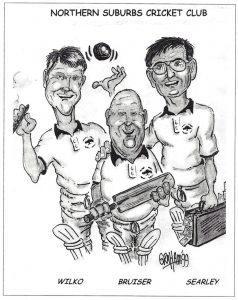
Lorn Park Oval
The last decade has seen further ground improvements that have transformed Lorn Park into what has become generally recognised as the premier cricket ground in Maitland.
This situation was made possible by the transfer of the Rugby Union to Marcellin Park; by the active work of the Club’s committee and the Lorn Park Recreation Board; and above all by the tireless efforts to improve the condition of the pitch, ground, and facilities by the curator, Alan Mudd.
A number of improvements were carried out to bring the ground up to first class condition. The pitch area was returfed and extended; a new sightscreen was constructed at the Bowling Club end; the old sightscreen was repaired and repainted; the practice area was redesigned and renewed; the underground watering system was extended, and the purchase of a ride-on mower enabled the playing surface on the outfield to be greatly improved. Recently landscaping and paving have enhanced the area around the clubhouse and there is even now a flagpole for the Club to fly its own standard.
A major project undertaken to improve the appearance and condition of Lorn Park was the restoration of a picket fence around the ground, as had been the case back in 1923. This became known as the Lorn Park Heritage Restoration Project and at the forefront of the fundraising activities were Hunter Calder, David Johnston, and Bruce Leary. Mainly through their efforts, sufficient finance was raised to carry out the project – Council contributed $20,000; a grant of $9,000 was obtained from the Department of Sport and Recreation, and $17,000 was raised through the donations of various local businesses and Life Members.
An official opening day for the new facilities was held on 12th February 2000 with the honours being performed by the local State Member, John Price, and the Mayor of Maitland, Peter Blackmore.
Various sections around the metal picket fence were named in honour of three individuals who had made a major contribution to the improved facilities and to the Club – the Hunter Calder Gate outside the pavilion entrance; the John Wilkinson Gate leading to the Lorn Park Bowling Club; and the Alan Mudd “Snoopy” Practice Complexnear the new practice area.
On 18th November 2000, the second stage of the Lorn Park Heritage Restoration Project was marked with the official naming of the refurbished training nets the Norman Mudd Training Complex, and the area surrounding the nets as the Keith Smith Reserve – fitting tributes in honour of two of Norths “greats”!
With the marked improvement of the pitch and ground conditions during this period, Lorn Park became the venue for a number of important fixtures – a three day “Test match” between the Emu Colts and the Canterbury Kiwi Emerging Players in January 1999; a match between a Central North team and a touring South African Country team in October 1999; and a Combined Country Trial match between Northern and Southern NSW Colts in January 2001.
So favourable were the ground reports from the Combined Trial Country match, Lorn Park became the venue in September 2001 for the NSW Pura Cup team’s pre-season training camp under the direction of State Coach, Steve Rixon.
Following on from this, Lorn Park was used for the staging on 16th September 2001 of the Ivor Ewin Place of Origin match between the Country Origin team, captained by Shane Lee, and the City Origin team, captained by Stuart MacGill. This was only the second time that this match had been played outside of Sydney – the other time being in 1994 in Maitland at Robins Oval for the Association’ Centenary.
During the 2001-02 season, the ground was also used to host two matches in the Australian Under 19 Championships and a semi-final of the NRMA Cup competition.
In 2002-03 Lorn Park was again the venue for NRMA Cup matches and for a one-day “International Match” between the touring New Zealand Canterbury Emerging Players and the Northern NSW Emus team.
All in all, the ground improvements and the representative matches that have been played at Lorn Park have given the oval the reputation of being one of the top country grounds in NSW – a reputation befitting the ground of a Club with a proud tradition extending over a hundred years.
Lorn Park Heritage Project Open Day
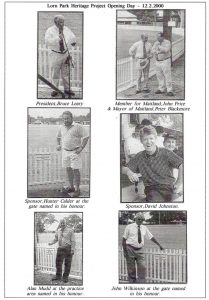
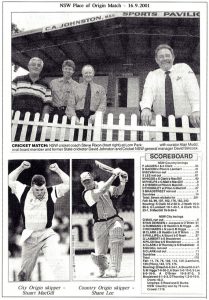
Life Members
Note: Following the amalgamation of Northern Districts and Bolwarra Clubs in 1987, life membership of both clubs was automatically transferred to Northern Suburbs. (*) indicates deceased.
Northern Division
E.P Bowden*
H.A Johnston*
W.C Johnston*
A Pilgrim*
Northern Districts
W. Jarrett*
N. Mudd*
Ken Smith*
J. Lindsay*
A. D’Ombrain*
C.A Johnston*
A.B Johnston*
B.H Johnston*
Keith Smith
Doug Rawling*
R. Moylan Snr.*
T. Deamer
D. Nichols
D. Rutherford
A. Mudd
M. Hopkins
Black Hill (Bolwarra)
G. Sutherland
C. Ellis
D. Latter
L. Wood
G. March
Glen Watts
D. Andrews
T. Holden
Northern Suburbs
E. Hill
B. Leary
P. Johns
R. Campbell (Ex-BH)
Greg Watts (Ex-BH)
J. Wilkinson
G. Searle
R. Faulkner
P. McLaughlin (Ex-BH)
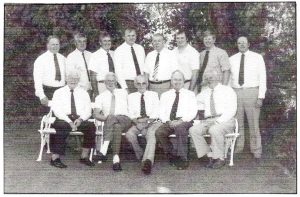
Front row: Colin Johnston, Keith Smith, Norm Mudd, Clem Ellis, Don Latter
Authors Note
“Our heroes rest in sleep profound,
And fields beyond their ken abound;
But flight of time shall ne’er efface
The deeds that light their trysting-place.”
Early Cricket in Sydney by Jas Scott
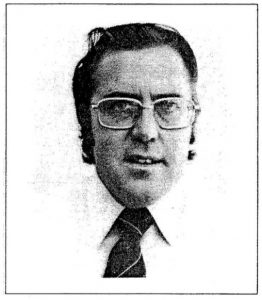
This season Norths Cricket Club celebrates its Centenary, marking a hundred years since the formation of the Club, then known as Northern Division, in 1903.
While not the oldest of the Maitland Clubs still in existence, the Club has the distinction of being the one with the longest history of continued participation in the competitions of the local Association. Over the past hundred years, the Club has produced many gifted and talented players, a number of whom have gone on to high representative honours, including Sheffield Shield selection. At the same time the Club has catered for many “run-of-the mill” players who, regardless of their ability or age, have turned out on Saturday afternoons in a variety of grades to enjoy the game and the fellowship that goes along with it, both on and off the field.
The Club has also built up a proud tradition – one that has evolved through its history of development and through the achievements of its Club members over the past century.
During this time there have been two name changes and an amalgamation but through all these changes, the tradition has continued.
This Centenary publication aims to outline the Club’s history and to recognise the contribution of some of the players and administrators who have helped to create that proud tradition.
It is hoped that the material in the booklet will thereby provide Club members, both past and present, with the opportunity to reflect on the memories of their own playing days with Norths and at the same time will help to preserve the tradition of the Club for those who follow.
Lindsay Wood
Life Member



